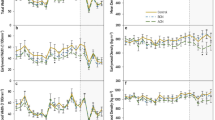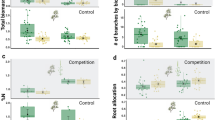Abstract
Natural variation in ungulate browsing behavior interferes with the understanding of plant morphological and biochemical responses to herbivory. To investigate mechanisms for recovery from herbivory, we examined growth patterns and biosynthesis of terpenoids under simulated browse (three clipping intensities) and supplemental mineral nutrition (four levels of controlled-release fertilization) for Douglas-fir [Pseudotsuga menziesii (Mirb.) Franco], western hemlock (Tsuga heterophylla Raf. Sarg.), and western red-cedar (Thuja plicata Donn ex D. Don) seedlings on a reforestation site in Northwestern Oregon, USA, that was fenced to exclude ungulates. Higher clipping intensities increased relative height growth (at cost of diameter growth) for all the species. Only western red-cedar showed a decline in monoterpene concentrations with increasing clipping severity, suggesting prioritization in biosynthesis of terpenoids for this species. Douglas-fir and western hemlock responded to fertilization mostly through increased growth. Western red-cedar growth responses to fertilization were less pronounced, but monoterpene concentrations were 2–3 times higher compared to non-fertilized trees. Douglas-fir and western hemlock browse recovery and responses to fertilization consisted primarily of increased growth, while western red-cedar balanced growth promotion with production of chemical defense compounds. Our data suggests the evolution of species-dependent resource allocation strategies in response to both browse and soil nutrient availability.


Similar content being viewed by others
References
Anderson DA (1983) Reproductive success of Columbian black-tailed deer in a sewage-fertilized forest in western Washington. J Wildl Manag 47:243–247
Bazzaz FA, Chiarello NR, Coley PD, Pitelka LF (1987) Allocating resources to reproduction and defense. Bioscience 37(1):58–67
Belsky AJ (1986) Does herbivory benefit plants? A review of the evidence. Am Nat 127:870–892
Bergvall UA, Leimar O (2005) Plant secondary compounds and the frequency of food types affect food choice by mammalian herbivores. Ecology 86(9):2450–2460
Black HC, Dimock EJ, Evans J, Rochelle, JA (1979) Animal damage to coniferous plantations in Oregon and Washington: part 1. A survey, 1963–1975, vol 25. Oregon State University Research Bulletin, Corvallis
Blanch JS, Peñuelas J, Llusiá J (2007) Sensitivity of terpene emissions to drought and fertilization in terpene-storing Pinus halepensis and non-storing Quercus ilex. Physiol Plantarum 131:211–225
Brix H (1971) Effects of nitrogen fertilization on photosynthesis and respiration in Douglas-fir. Forest Sci 17(4):407–414
Buchanan BB, Gruisssem W, Jones RL (2000) Biochemistry and molecular biology of plants. American Society of Plant Physiologist, Rockville, p 1318
Burney OT, Jacobs DF (2011) Ungulate herbivory of regenerating conifers in relation to foliar nutrition and terpenoid production. Forest Ecol Manag 262:1834–1845
Burney OT, Davis AS, Jacobs DF (2012) Phenology of foliar and volatile terpenoid production for Thuja plicata families under differential nutrient availability. Environ Exp Bot 77:44–52
Carlson WC (1981) Effects of controlled-release fertilizers on shoot and root development of outplanted western hemlock (Tsuga heterophylla Raf. Sarg.) seedlings. Can J Forest Res 11:752–757
Carlson WC, Preisig CL (1981) Effects of controlled-release fertilizers on the shoot and root development of Douglas-fir seedlings. Can J Forest Res 11:230–242
Chapin FS (1980) The mineral nutrition of wild plants. Ann Rev Ecol Syst 11:233–260
Coa B, Dang QL, Yü X, Zhang S (2008) Effects of CO2 and nitrogen on morphological and biomass traits of white birch (Betula papyrifera) seedlings. Forest Ecol Manag 254:217–224
Coates KD, Burton PJ (1999) Growth of planted tree seedlings in response to ambient light levels in Northwestern interior cedar-hemlock forests of British Columbia. Can J For Res 29:1374–1382
Crouch GL, Radwan MA (1981) Effects of nitrogen and phosphorus fertilizers on deer browsing and growth of young Douglas-fir. USDA For Serv, Pac Northw Res Exp Stn, Res Note 368, p 15
Duncan AJ, Hartley SE, Thurlow M, Young S, Staines BW (2001) Clonal variation in monoterpene concentrations in Sitka spruce (Picea sitchensis) saplings and its effect on their susceptibility to browsing damage by red deer (Cervus elaphus). Forest Ecol Manag 148:259–269
Elliott S, Loudon A (1987) Effects of monoterpene odors on food selection by red deer calves (Cervus elaphus). J Chem Ecol 13:1343–1349
Fraser LH, Chanway CP, Turkington R (1995) The competitive role of Gaultheria shallon on planted western hemlock and western red cedar saplings on Northern Vancouver Island. Forest Ecol Manag 75:27–39
Graff JE, Hermann RK, Zaerr JB (1999) Dry matter and nitrogen allocation in western redcedar, western hemlock, and Douglas fir seedlings grown in low- and high-N soils. Ann For Sci 56:529–538
Haase DL, Rose R, Trobaugh J (2006) Field performance of three stock sizes of Douglas-fir container seedlings grown with slow-release fertilizer in the nursery growing medium. New Forest 31:1–24
Hawkins BJ, Burgess D, Mitchell AK (2005) Growth and nutrient dynamics of western hemlock with conventional or exponential greenhouse fertilization and planting in different fertility conditions. Can J For Res 35:1002–1016
Herms DA (2002) Effects of fertilization on insect resistance of woody ornamental plants: reassessing an entrenched paradigm. Environ Entomol 31(6):923–933
Hofmeyer PV, Seymour RS, Kenefic LS (2010) Production ecology of Thuja occidentalis. Can J For Res 40:1115–1164
Jacobs DF, Salifu KF, Seifert JR (2005) Growth and nutritional response of hardwood seedlings to controlled-release fertilization at outplanting. Forest Ecol Manag 214:28–39
Kimball BA, Russell JH, Griffin DL, Johnston JJ (2005) Response factor considerations for the quantitative analysis of western redcedar (Thuja plicata) foliar monoterpenes. J Chromatogr Sci 43:253–258
Laine J, Mannerkoski H (1980) Lannoituksen vaikutus mäntytaimikoiden kasvuun ja hirvituhoihin karuilla ojitetuilla nevoilla. Summary: effect of fertilization on tree growth and elk damage in young Scots pine stands planted on drained, nutrient-poor open bogs. Acta Forestalia Fennica 166:1–45
Lerdau M, Matson P, Fall R, Monson R (1995) Ecological controls over monoterpene emissions from Douglas-fir (Pseudotsuga menziesii). Ecology 76(8):2640–2647
Mabry CM, Wayne PW (1997) Defoliation of the annual herb Abutilon theophrasti: mechanisms underlying reproductive compensation. Oecologia 111(2):225–232
Månsson J, Bergström R, Danell K (2009) Fertilization—effects on deciduous tree growth and browsing by moose. Forest Ecol Manag 258:2450–2455
Manter DK, Kavanagh KL, Rose CL (2005) Growth response of Douglas-fir seedlings to nitrogen fertilization: importance of Rubisco activation state and respiration rates. Tree Physiol 25:1015–1021
Niinemets U, Hauff K, Bertin N, Tenhunen JD, Steinbrecher R, Seufert G (2002) Monoterpene emissions in relation to foliar photosynthetic and structural variables in Mediterranean evergreen Quercus species. New Phytol 153:243–256
Nolte DL, Kimball BA, Perry KR, Villalba JJ, Provenza FD (2004) Effects of forage nutritional quality (energy and protein) on deer acceptance of foods containing secondary metabolites. Proc Vertebr Pest Conf 21:338–345
Peñuelas J, Estiarte M (1998) Can elevated CO2 affect secondary metabolism and ecosystem function? Trends Ecol Evol 13:20–24
Puettman KJ, Saunders MR (2001) Patterns of growth compensation in eastern white pine (Pinus strobus L.): the influence of herbivory intensity and competitive environments. Oecologia 129(3):376–384
Rose R, Ketchum JS (2002) Interaction of vegetation control and fertilization on conifer species across the Pacific Northwest. Can J For Res 32:136–152
Schwartz CC, Nagy JG, Regelin WL (1980) Juniper oil yield, terpenoid concentration, and antimicrobial effects on deer. J Wildlife Manag 44:107–113
Stamp N (2003) Out of the quagmire of plant defense hypothesis. Q Rev Biol 78:23–55
Strauss SY, Agrawal AA (1999) The ecology and evolution of plant tolerance to herbivory. Trends Ecol Evol 14(5):179–185
Tingey DT, Manning M, Grothaus LC, Burns WF (1980) Influence of light and temperature on monoterpene emission rates from slash pine. Plant Physiol 65:797–801
Vourc’h G, Martin JL, Duncan P, Escarré J, Clausen TP (2001) Defensive adaptations of Thuja plicata to ungulate browsing: a comparative study between mainland and island populations. Oecologia 126:84–93
Vourc’h G, De Garine-Wichatitsky M, Labbe A, Rosolowski D, Martin JL, Fritz H (2002) Monoterpene effect on feeding choice by deer. J Chem Ecol 28:2411–2427
Vourc’h G, Russell J, Gillon D, Martin JL (2003) Short-term effect of defoliation on terpene content in Thuja plicata. Ecoscience 10(2):161–167
Webb WL (1977) Seasonal allocation of photoassimilated carbon in Douglas-fir seedlings. Plant Physiol 60:320–322
Welch BL, McArthur ED (1981) Variation of monoterpenoid content among subspecies and accessions of Artemisia tridentate grown in a uniform garden. J Range Manag 34(5):380–384
Acknowledgments
Funding support for this research was provided by the Oregon Department of Forestry. J. Travers, J. Brandt, and D. Robin with the Oregon Department of Forestry provided additional logistical support. A. Davis, M. Aghai, J. Sloan, P. Woolery, and South Fork crew members assisted in the installation and/or measurements of field sites. GC/MS service and consultation was provided by K. Wood with the Purdue University Campus-Wide Mass Spectrometry Center. The authors extend a special acknowledgment to K. Powell for the initial inspiration in developing this project. The communicating Editor and two anonymous reviewers provided helpful comments that improved the manuscript.
Author information
Authors and Affiliations
Corresponding author
Additional information
Communicated by J. E. Carlson.
Rights and permissions
About this article
Cite this article
Burney, O.T., Jacobs, D.F. Terpene production and growth of three Pacific Northwest conifers in response to simulated browse and nutrient availability. Trees 26, 1331–1342 (2012). https://doi.org/10.1007/s00468-012-0709-4
Received:
Revised:
Accepted:
Published:
Issue Date:
DOI: https://doi.org/10.1007/s00468-012-0709-4




